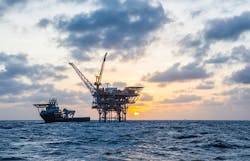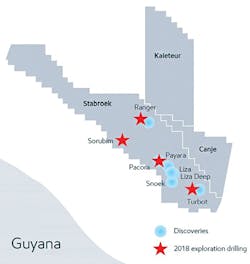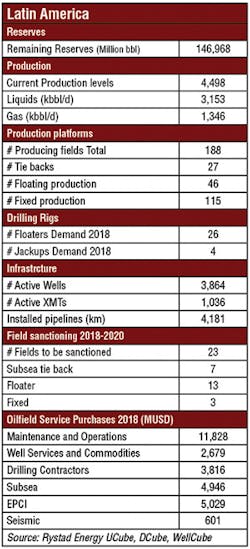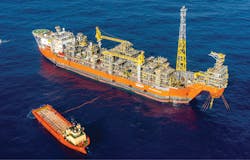Project activity ramping up across Latin America
Seventh discovery made offshore Guyana
Jessica Stump
Assistant Editor
The Juniper platform is installed in 361 ft of water off southeastern Trinidad. (Courtesy BP)
As the oil price stabilizes and confidence returns to the industry, operators are propelling upstream activities throughout Latin America, especially in deepwater and frontier areas.
Since May 2015, Exxon Mobil Corp. and its partners have recorded seven deepwater oil discoveries on the Stabroek block offshore Guyana. The drillshipStena Carron was used for all the exploration and appraisal wells across the 26,800-sq km (10,348-sq mi) Stabroek block. ExxonMobil affiliate Esso Exploration and Production Guyana Ltd. (EEPGL) is the operator and holds 45% interest in the block, along with Hess Guyana Exploration Ltd. (30%) and CNOOC Nexen Petroleum Guyana Ltd. (25%).
ExxonMobil estimates recoverable resources from the Liza, Liza Deep, Payara, Snoek, and Turbot finds at more than 3.2 Bboe.
In January 2018, the Ranger-1 well encountered about 230 ft (70 m) of good-quality, oil-bearing carbonate reservoir in 8,973 ft (2,735 m) of water. The Ranger discovery also proved a third new play concept on the block. The next month, the Pacora-1 well encountered about 65 ft (20 m) of high-quality, oil-bearing sandstone reservoir in 6,781 ft (2,067 m) of water. Pacora is 4 mi (6.4 km) west of Payara, which is estimated to contain 500 MMboe.
Hess CEO John Hess said: “The giant Payara field, which is planned as the third development offshore Guyana, will now include Pacora resources – increasing the size of the FPSO and bringing expected gross production from the first three phases of development to more than 500,000 b/d.”
TheStena Carronwill next drill the Liza-5 well and complete a well test, which will be used to assess concepts for the Payara development. It will then conduct additional exploration and appraisal on the block.
In June 2017, the partners sanctioned the $3.2-billion Liza Phase 1 development, which includes a subsea production system, an FPSO vessel, and four subsea drill centers consisting of 17 wells: eight producers, six water injectors, and three gas injectors. It is expected to develop about 450 MMbbl of oil. Conversion of the Bahamas-flagged VLCCTina into the Liza FPSO is under way at the Keppel Shipyard in Singapore. The work scope includes refurbishment and life extension works, such as upgrades to the living quarters, fabrication and installation of spread mooring systems, and installation and integration of topsides modules. Topsides construction is under way at the Dyna-Mac yard. Once complete, the FPSO will be able to produce up to 120,000 b/d of oil, with associated gas treatment capacity of around 170 MMcf/d and water injection capacity of roughly 200,000 b/d. The vessel will be spread moored in a water depth of 5,000 ft (1,525 m) and will be able to store 1.6 MMbbl of crude oil.
Map of the discoveries offshore Guyana. (Courtesy ExxonMobil)
Under a three-year contract, the drillshipNoble Bob Douglas is expected to start development drilling in the first half of 2018. First oil is targeted for March 2020. According to Hess, Liza Phase 1 has a break-even price of $35/bbl.
Planning for Liza Phase 2 is under way. EEPGL’s lead concept involves a second FPSO located about 5.3 mi (8.5 km) east of the Phase 1 FPSO, with a production capacity of up to 220,000 b/d. Two subsea drill centers are envisioned consisting of 35-40 producer and injector wells. Startup is targeted for 2022.
Elsewhere off Guyana, Tullow Oil and Eco (Atlantic) Oil & Gas have identified various leads on the Orinduik block that could contain more than 1 Bboe. The leads are drawn from studies of several thousand kilometers of 2D data, regional well logs and seismic correlations to ExxonMobil’s nearby Stabroek block wells. Some of the leads appear to be equivalent in age to the Liza reservoir. Last year, WesternGeco completed a 984-sq mi (2,550-sq km) 3D seismic survey over Orinduik, and PGS is currently processing the results in the UK. Total is considering farming in to this block.
BP Trinidad and Tobago (bpTT) has sanctioned the Angelin gas project in the northern Columbus basin. The project will feature the company’s 15th offshore production facility, 37 mi (60 km) off the southeast coast in a water depth of 213 ft (65 m). Development will include four wells and will have a production capacity of about 600 MMcf/d. Gas from Angelin will flow to the Serrette platform hub via a new 13-mi (21-km) pipeline. Drilling is due to begin in 4Q 2018, and first gas is expected in 1Q 2019. McDermott International is close to completing the jacket and topsides fabrication at its yard in Altamira, Mexico.
Last August, bpTT began production from the Juniper gas field, its first subsea field development. The development produces gas from the Corallita and Lantana fields via the new Juniper platform, 50 mi (80 km) off the southeast coast of Trinidad in 361 ft (110 m) of water. It includes five subsea wells and will have a production capacity of about 590 MMcf/d. Gas then flows to the Mahogany B hub via a new 6.2-mi (10-km) flowline.
bpTT also unlocked about 2 tcf of gas in place with the Savannah and Macadamia exploration wells. The Savannah exploration well was drilled into an untested fault block east of the Juniper field in water depths of more than 500 ft (152 m), about 50 mi off the country’s southeast coast. The well penetrated hydrocarbon-bearing reservoirs in two main intervals with about 650 ft (198 m) net pay. The company says that it expects to develop these reservoirs via future tieback to the Juniper platform.
The Macadamia well was drilled to test exploration and appraisal segments below the existing SEQB discovery, which sits 6.2 mi south of the producing Cashima field. The well penetrated hydrocarbon-bearing reservoirs in seven intervals with about 600 ft (183 m) net pay. Combined with the shallow SEQB gas reservoirs, the Macadamia discovery is expected to support a new platform within the post-2020 timeframe.
Petrobras, operator of the Libra Consortium, has awarded MODEC Inc. the supply, charter, and operations contract for the Mero Pilot FPSO. MODEC is responsible for the engineering, procurement, construction, mobilization, installation, and operation of the FPSO, including topsides processing equipment as well as hull and marine systems. SOFEC Inc., a MODEC group company, will design and supply the spread mooring system.
The FPSO will be deployed at the Mero field, located in the northwestern area of the Libra block in the presalt Santos basin, about 112 mi (180 km) off the coast of Rio de Janeiro. Water depth is 6,890 ft (2,100 m). Estimated recoverable volumes are 3.3 Bbbl.
The FPSO will be capable of processing 180,000 b/d of crude oil, 12 MMcm/d of gas, 225,000 b/d of water injection, and will have a storage capacity of 1.4 MMbbl of crude oil. The project includes the interconnection of up to 17 wells to the FPSO. First oil is planned for 2021. Petrobras and MODEC said that the vessel will be delivered with Brazilian local content. The firm charter period of the contract is 22 years.
The Libra Consortium is formed by Petrobras (40%), Shell Brasil (20%), Total (20%), CNPC (10%), CNOOC Ltd. (10%), and state-owned Pré-Sal Petróleo S.A., as manager of the production-sharing contract. The consortium plans to eventually deploy four new production systems on the Mero field and to continue exploration of the remaining area of the Libra block, the term of which has been extended by a further 27 months.
OOGTK Libra, a joint venture between Brazil’s Odebrecht Oil & Gas and Teekay Offshore, operates thePioneiro de Libra under charter to Petrobras. (Courtesy Teekay Corp.)
Late last year, first oil began flowing from the Libra field’s early production system. The FPSOPioneiro de Libra has a production capacity of 50,000 b/d of oil. This program is designed to further appraise the field and to generate early revenue.
MODEC also received the charter and operations services contract for the Sépia FPSO. The firm charter period is 21 years. The FPSO will be capable of processing 180,000 b/d of crude oil, 212 MMcf/d of gas, 240,000 b/d of water injection, and will have a storage capacity of 1.4 MMbbl of crude oil. It will be deployed at the Petrobras-operated Sépia field in the presalt Santos basin about 155 mi (250 km) offshore Rio de Janeiro. Water depth is about 7,218 ft (2,200 m).
Offshore the Falkland Islands, Rockhopper Exploration and operator Premier Oil expect to sanction the Sea Lion Phase 1 project in the North Falkland basin by the end of the year. Activity during the second half of 2017, according to Rockhopper, focused on the commercial, fiscal and financing elements required to secure the $1.5 billion of capex needed to deliver first oil. Diamond Offshore Drilling has a letter of intent to provide a rig to drill the Phase 1 wells. Premier submitted the latest draft of the field development plan to the Falkland Islands government in November 2017, and the company expects the public consultation for the environmental impact statement to get under way soon.




